- Trang chủ >>
- Khoa Học Tự Nhiên >>
- Vật lý
Conceptual foundations of quantum field theory
Bạn đang xem bản rút gọn của tài liệu. Xem và tải ngay bản đầy đủ của tài liệu tại đây (6.54 MB, 420 trang )
Conceptual foundations of quantum field theory
Quantum field theory is a powerful language for the description of the subatomic constituents of the physical world and the laws and principles that
govern them. This book contains up-to-date in-depth analyses, by a group of
eminent physicists and philosophers of science, of our present understanding
of its conceptual foundations, of the reasons why this understanding has to
be revised so that the theory can go further, and of possible directions in
which revisions may be promising and productive.
These analyses will be of interest to students of physics who want to know
about the foundational problems of their subject. The book will also be of
interest to professional philosophers, historians and sociologists of science. It
contains much material for metaphysical and methodological reflection on
the subject; it will also repay historical and cultural analyses of the theories
discussed in the book, and sociological analyses of the way in which various
factors contribute to the way the foundations are revised. The authors also
reflect on the tension between physicists on the one hand and philosophers
and historians of science on the other, when revision of the foundations
becomes an urgent item on the agenda.
This work will be of value to graduate students and research workers in
theoretical physics, and in the history, philosophy and sociology of science,
who have an interest in the conceptual foundations of quantum field theory.
For Bob and Sam
www.pdfgrip.com
Conceptual foundations of
quantum field theory
EDITOR
TIAN YU CAO
Boston University
CAMBRIDGE
UNIVERSITY PRESS
www.pdfgrip.com
PUBLISHED BY THE PRESS SYNDICATE OF THE UNIVERSITY OF CAMBRIDGE
The Pitt Building, Trumpington Street, Cambridge, United Kingdom
CAMBRIDGE UNIVERSITY PRESS
The Edinburgh Building, Cambridge CB2 2RU, UK
40 West 20th Street, New York NY 10011-4211, USA
477 Williamstown Road, Port Melbourne, VIC 3207, Australia
Ruiz de Alarcon 13, 28014 Madrid, Spain
Dock House, The Waterfront, Cape Town 8001, South Africa
http ://www. Cambridge. org
© Cambridge University Press 1999
This book is in copyright. Subject to statutory exception
and to the provisions of relevant collective licensing agreements,
no reproduction of any part may take place without
the written permission of Cambridge University Press.
First published 1999
First paperback edition 2004
Typeset in 10/12V£pt Times [wv]
A catalogue record for this book is available from the British Library
Library of Congress Cataloguing in Publication data
Conceptual foundations of quantum field theory / editor, Tian Yu Cao.
p. cm.
Includes index.
ISBN 0 521 63152 1 hardback
1. Quantum field theory—Congresses. I. Cao, Tian Yu, 1941— .
QC174.45.A1C646 1999
530.14'3-dc21 98-24394 CIP
ISBN 0 521 63152 1 hardback
ISBN 0 521 60272 6 paperback
www.pdfgrip.com
Contents
List of contributors
Preface
Photographs of the conference
Introduction: Conceptual issues in quantum field theory
ix
xi
xii
1
TIAN YU CAO
I Philosophers9 interest in quantum field theory
1 Why are we philosophers interested in quantum field theory?
28
28
TIAN YU CAO
2 Quantum field theory and the philosopher
34
MICHAEL REDHEAD
II Three approaches to the foundations of quantum field theory
3 The usefulness of a general theory of quantized
fields
41
41
A. S. WIGHTMAN
4 Effective field theory in condensed matter physics
47
R. SHANKAR
5 The triumph and limitations of quantum field theory
56
DAVID J. GROSS
6 Comments
68
SAM TREIMAN
Session discussions
70
III
7 Does quantum field theory need a foundation?
74
SHELDON LEE GLASHOW
IV Mathematics, statistics and quantum field theory
8 Renormalization group theory: its basis and formulation in
statistical physics
89
89
MICHAEL E. FISHER
9 Where does quantum field theory fit into the big picture?
ARTHUR JAFFE
www.pdfgrip.com
136
vi
Contents
10 The unreasonable effectiveness of quantum field theory
148
ROMAN JACKIW
11 Comments: The quantum field theory of physics and of mathematics
161
HOWARD J. SCHNITZER
Session discussions
164
V Quantum field theory and space-time
Introduction
166
166
JOHN STACHEL
12 Quantum field theory and space-time - formalism and reality
176
BRYCE DEWITT
13 Quantum field theory of geometry
187
ABHAY ASHTEKAR a n d JERZY LEWANDOWSKI
14 'Localization' in quantum field theory: how much of QFT is
compatible with what we know about space-time?
207
CARLO ROVELLI
15 Comments
233
JOHN STACHEL
VI
16 What is quantum field theory, and what did we think it was?
241
STEVEN WEINBERG
17 Comments
252
LAURIE M. BROWN and FRITZ ROHRLICH
Session discussions
259
VII Renormalization group
18 What is fundamental physics? A renormalization group perspective
264
264
DAVID NELSON
19 Renormalization group: an interesting yet puzzling idea
268
TIAN YU CAO
VIII Non-Abelian gauge theory
20 Gauge fields, gravity and Bohm's theory
287
287
NICK HUGGETT a n d ROBERT WEINGARD
21 Is the Aharonov-Bohm effect local?
298
RICHARD HEALEY
Session discussions
310
IX The ontology of particles or fields
22 The ineliminable classical face of quantum field theory
314
314
PAUL TELLER
23 The logic of quanta
324
STEVEN FRENCH and DECIO KRAUSE
www.pdfgrip.com
Contents
24 Do Feynman diagrams endorse a particle ontology? The roles of
Feynman diagrams in S-matrix theory
vii
343
DAVID KAISER
25 On the ontology of QFT
357
FRITZ ROHRLICH
X
368
26 Panel discussion
STANLEY DESER
(moderator),
SIDNEY COLEMAN,
SHELDON LEE GLASHOW, DAVID GROSS, STEVEN WEINBERG,
ARTHUR WIGHTMAN
Name index
Subject index
387
391
www.pdfgrip.com
www.pdfgrip.com
Contributors
Abhay Ashtekar
Center for Gravitational Physics and Geometry, Department of Physics,
Penn State University, University Park, PA 16802, USA
Laurie M. Brown
Department of Physics and Astronomy, Northwestern University, Evenston,
IL 60208, USA
Tian Yu Cao
Department of Philosophy, Boston University, Boston, MA 02215, USA
Sidney Coleman
Department of Physics, Harvard University, Cambridge, MA 02138, USA
Stanley Deser
Department of Physics, Brandeis University, Waltham, MA 02254, USA
Bryce DeWitt
Department of Physics, University of Texas at Austin, Austin, TX 78712, USA
Michael E. Fisher
Institute for Physical Science and Technology, University of Maryland at College Park,
MD 20741-2431, USA
Steven French
Department of Philosophy, University of Leeds, Leeds, LS2 9JT, UK
Sheldon Lee Glashow
Department of Physics, Harvard University, Cambridge, MA 02138, USA; and
Department of Physics, Boston University, Boston, MA 02215, USA
David Gross
Department of Physics, Princeton University, Princeton, NJ 08544-0708, USA
Richard Healey
Department of Philosophy, University of Arizona, Tucson, AZ 85721, USA
Nick Huggett
Department of Philosophy, University of Illinois at Chicago, Chicago, IL 60607, USA
Roman Jackiw
Department of Physics, Massachusetts Institute of Technology, Cambridge,
MA 02139, USA
ix
www.pdfgrip.com
x
List of contributors
Arthur Jaffe
Departments of Physics and Mathematics, Harvard University, Cambridge, MA 02138,
USA
David Kaiser
Department of History of Science, 235 Science Center, Harvard University, Cambridge,
MA 02138, USA
Decio Krause
Department of Mathematics, Federal University of Parana, 81531-990, Curitiba, PR,
Brazil
Jerzy Lewandowski
Institute of Theoretical Physics, University of Warsaw, Warsaw, Poland; and
Max Planck Institut fur Gravitationphysik, Schlaatzweg 1, 14473 Potsdam, Germany
David Nelson
Department of Physics, Harvard University, Cambridge, MA 02138, USA
Michael Redhead
Wolfson College, Cambridge University, Cambridge, CB3 9BB, UK
Fritz Rohrlich
Department of Physics, Syracuse University, Syracuse, NY 13210, USA
Carlo Rovelli
Department of Physics, University of Pittsburgh, Pittsburgh, PA 15260, USA
Howard Schnitzer
Department of Physics, Brandeis University, Waltham, MA 02254, USA
R. Shankar
Department of Physics, Yale University, PO Box 6666, New Haven,
CT 06511-8167, USA
John Stachel
Department of Physics, Boston University, Boston, MA 02215, USA
Paul Teller
Department of Philosophy, University of California at David, CA 95616, USA
Sam Treiman
Department of Physics, Princeton University, Princeton, NJ 08544-0708, USA
Steven Weinberg
Department of Physics, University of Texas at Austin, Austin, TX 78712, USA
Robert Weingard
Department of Philosophy, Rutgers University, New Brunswick, NJ 08903, USA
Arthur S. Wightman
Departments of Mathematics and Physics, Princeton University, Princeton,
NJ 08544-0708, USA
www.pdfgrip.com
Preface
This volume is the result of a two-tier conference consisting of a two-day symposium
followed by a one-day workshop, which was first conceived by a group of philosophers and historians of physics in the Greater Boston area, the core members of
which were Babak Ashirafi of Massachusetts Institute of Technology, Ronald Anderson of Boston College, Tian Yu Cao of Boston University, David Kaiser of Harvard
University and Silvan S. Schweber of Brandeis University, and then sponsored by the
Center for Philosophy and History of Science, Boston University, and held at Boston
University on March 1-3 1996, withfinancialsupport provided by the U.S. National
Science Foundation and the Boston Philosophy of Science Association.
The intention was to offer an opportunity for a group of leading scholars to present
their penetrating and in-depth analysis of various formulations and understandings of
the foundations of quantum field theory, and to investigate philosophical and historical issues associated with these formulations, and also to provide a forum for the
desirable, mutually beneficial but difficult exchange of views and ideas between
physicists and mathematicians on the one side and philosophers and historians on
the other. Although the experiment in dialogue was not completely successful, the
publication of this volume will make the valuable contributions to this conference
as well as interesting material about the tension between two groups of scholars accessible to a much wider audience for further theoretical, philosophical, historical, and
sociological analysis.
During the long period of preparation for the conference, in addition to many
planning meetings by our group, we also received advice and numerous suggestions
from the prospective participants, and also from Professor Gerald Holton of Harvard
University and Professor Robert S. Cohen of Boston University. We are grateful
for their intellectual and spiritual support. Thanks also to Ms Corinne Yee and Ms
Carolyn A. Fahlbeck, without whose effective handling of the complexities that constantly emerged in the process of meetings the conference would have been practically
impossible.
Tian Yu Cao
Boston University
XI
www.pdfgrip.com
Xll
Photographs of the conference
The 1996 Boston University Conference on the Foundations of Quantum Field
Theory
Stanley Deser, Sheldon Lee Glashow and David Gross
www.pdfgrip.com
Photographs of the conference
Silvan S. Schweber, David Gross, R. Shankar, Sam Treiman and Arthur
Wightman
Arthur Jaffe, Peter Galison, Roman Jackiw, Michael E. Fisher and Howard
Schnitzer
www.pdfgrip.com
Xlll
XIV
Photographs of the conference
Sheldon Lee Glashow
Abhay Ashtekar, Carlo Rovelli, Bryce DeWitt and John Stachel
www.pdfgrip.com
Photographs of the conference
Steven Weinberg
Stanley Deser, David Gross, Sheldon Lee Glashow, Sidney Coleman, Steven
Weinberg and Arthur Wightman
www.pdfgrip.com
xv
XVI
Photographs of the conference
Tian Yu Cao, Michael E. Fisher and David Nelson
Robert Weingard, Richard Healey, Ronald Anderson, Roman Jackiw and J. B.
Kennedy
www.pdfgrip.com
Photographs of the conference
Steven French, Fritz Rohrlich, Paul Teller and David Kaiser
Laurie Brown and George Mackey
www.pdfgrip.com
xvn
XV111
Photographs of the conference
Jon Westling, Tian Yu Cao, Gerald Holton and Abner Shimony
R. Shankar, Francis Low and Sam Treiman
www.pdfgrip.com
Photographs of the conference
Laszlo Tisza, J. Scott Whitaker and Michael E. Fisher
Robert S. Cohen and Elena Mamchur
www.pdfgrip.com
xix
www.pdfgrip.com
Introduction
Conceptual issues in quantum field theory
TIAN YU CAO
Quantum field theory (QFT) is a powerful language for describing the subatomic
constituents of the physical world (quarks, leptons, gauge bosons, Higgs scalars,
and so on) and the laws and principles that govern them. Not only has it provided
a framework for understanding the hierarchical structure that can be built from
these constituents, it has also profoundly influenced the development of contemporary cosmology and deeply penetrated into the current conception and imagination of
the origin and evolution of the universe. For this reason, it has justifiably long been
taken to be the foundation of fundamental physics: elementary particle physics and
cosmology.
QFT reached its most spectacular success in the early 1970s in the standard model,
which is able to describe the fundamental interactions of nature within a unified
theoretical structure: the non-Abelian gauge theory. Ironically enough, however,
this success brought about a long period of stagnation in its conceptual development:
virtually nothing of physical importance occurred after the construction of the
standard model except for its detailed experimental verification. This situation can
be assessed in different ways, depending on what perspective we start with. For
example, the stagnation could be taken to be an indication that the theoretical
development of fundamental physics has come to an end. If we have already discovered all the fundamental laws, concepts and principles and integrated them
into a coherent structure of the standard model, how can we find anything fundamentally new? Thus 'No new physics!' is the slogan of the apologist for the standard
model.
Other physicists, such as string theorists, disagree. For them the success of the
standard model, or even the adequacy of QFT as a framework for describing and
understanding the nature and texture of the physical world, is far from perfect.
First, there are too many empirical parameters that cannot be derived and understood
from first principles. Second, the unification achieved is only partial: the electroweak
theory and quantum chromodynamics (QCD) for the quark-gluon interactions are
still separate pieces, let alone their unification with gravity. Moreover, the understanding and handling of physically meaningless infinities are far from satisfactory.
But most importantly, there is no way to incorporate gravity into the framework
of QFT. Thus the stagnation, from a string theorist's perspective, is only a temporary
silence before the thunderstorm, i.e. another conceptual revolution, which, though it
may not be related to the current pursuit of string theory, will radically revise many
basic assumptions and concepts adopted by QFT, such as point excitations and the
very basic ideas of space and time.
1
www.pdfgrip.com
2
Tian Yu Cao
Still other physicists, mainly mathematical physicists pursuing the algebraic
approach to QFT, feel that the stagnation reflects the profound crisis of traditional
(Lagrangian and functional integral) approaches to QFT. According to the most
critical among this category, the crisis has its roots in the inadequate pursuit of
quantization and the unjustifiable neglect of the locality principle, a condensed
form of the most important experience of 20th century physics. These led to the occurrence of infinities in the formalism, and to the superficial struggles for circumventing
them, which have prevented us from gaining a deep understanding of the intrinsic
meaning of local physics.1
Different assessments notwithstanding, the stagnation itself has provided physicists, mathematicians, and historians and philosophers of physics an opportunity
to examine carefully and reflect thoroughly upon where QFT stands now and how
it has evolved into the present situation. Conceptually, this kind of examination
and reflection is indispensable for a proper understanding of the true meaning of
QFT, and is also necessary for detecting and pursuing new directions in which
theoretical physics may develop.
1 Reality, ontology and structural realism
In undertaking a historical and philosophical analysis of conceptual issues in QFT,
different people naturally have different concerns. For mathematicians or mathematics-oriented physicists, the major concern is with the precise and rigorous proof
of the existence and consistency of the symbolic system adopted by QFT. Thus
plausible arguments adopted by practising physicists are far from satisfactory and
convincing, and a large part of the conceptual development of QFT, seen from this
perspective, seems to be restricted only to the so-called heuristic physics. For physicists who take QFT as part of empirical science, the physical interpretation of
the adopted mathematical structure, and its power to provide a unified description
of various observed or observable phenomena and make empirical predictions
are far more important than the formal concern with existence and consistency,
which they see as stifling their creative activities. For conceptual historians and in
particular for philosophers, the major concern is with the presuppositions about
the world adopted by QFT and the world picture suggested by its conceptual structure. They are also interested in understanding the successes and failures of QFT
and the significant changes in QFT in terms of its basic entities and theoretical
structure.
Different concerns lead to different opinions on various issues. But the basic dividing line that separates people is a philosophical one. If one takes an instrumentalist
attitude towards scientific concepts and theories, then there is no room for any
deep conceptual analysis. The only thing one can do is to compare concepts and
theories with experience and to see how successful they are in making verifiable predictions. Once the link between theory and the world is cut and removed, the success
or empirical adequacy becomes a primitive parameter and can have no explanation.
See B. Schroer (1996): 'Motivations and Physical Aims of Algebraic QFT,' manuscript (July 1996).
www.pdfgrip.com
Introduction: Conceptual issues in QFT
Thus no further conceptual analysis of the theoretical structure can be done, or is even
desirable.2
The realists, in contrast, make (and also try to justify) assumptions about the world
in their conceptual structure. That is, they assume that some concepts are the representation of the physical reality, while acknowledging that others may merely be
conventions. This entails a complexity in the theoretical structure, which is divided
in broad terms into two parts: a representative part and a conventional part. The
dividing line in most cases is vague, uncertain and shifting. And this requires a conceptual analysis to clarify the situation in a particular case at a particular moment of
the conceptual evolution of a theory. For example, the answer given now to the
question 'Are quarks real?' may be quite different from the answer given in 1964
when Gell-Mann first invented the concept of quarks. The situation with the Higgs
particle is similar but with more uncertainty at this moment. Still more difficult is
the question as to the reality of virtual particles: they can either be dismissed as an
artifact of the perturbative expansion in terms of free particle states, or seen as
entailed by the basic assumption of quantum fluctuations in QFT.
Another deep question involves the function played by conventions in a theory, and
asks why it is possible for them to play such a function. Some realists assume that conventions are not merely conventions but encode within them some structural information about the entities under investigation. Conventions, such as particular ways of
fixing the gauge, by definition can be replaced by other conventions. But the structural information encoded in them has to be retained, perhaps in a very complicated
way. In short, the whole issue concerning the relationship between formalism and
reality has its roots in the realistic attitude towards scientific theory and its ensuing
division of a theory into representative and conventional parts.
Further complications in the conceptual analysis of the theoretical structure come
from another assumption of the realists about the causal-hierarchical structure of the
physical world. Some physicists assume that entities and phenomena of the world are
causally connected and layered into quasi-autonomous domains. Usually a relatively
upper level domain (or relatively restrictive phenomena) can be understood or
derived, sometimes wholly, sometimes only partially, from a relatively deeper level
(or relatively universal phenomena), which is assumed to be primitive in the derivation. While the relationship between domains at different levels, which are grasped
by theoretical models at distinctive cognitive levels, is very complicated, involving
both reducibility and emergence, the causal-hierarchical relationship within each
domain in terms of the primitive and the derivative is universally assumed in scientific
practice. Without this assumption, no theoretical discourse would be possible.
This assumed causal-hierarchical structure of the world is believed to be embodied
in the hierarchy of conceptual structures of scientific theories. For the realists, a very
On the 'divisive rhetoric' of this paragraph, Arthur Fine has made very interesting comments: kI do not
think that the issues you discuss about ontology would simply be dismissed by an instrumentalist, as you
suggest. After all, as van Fraassen would say, the instrumentalist is committed to the QFT worldview
even if she does not necessarily believe it. So, the instrumentalist too would like to know to what she
is committed. I think that it is almost always a mistake when one says that the realist is interested
in this or that feature of science but the instrumentalist not.' (Private exchange.) It would be very
interesting to have a conceptual analysis of the ontological commitment and theoretical structure of a
scientific theory, such as quantum field theory, from an instrumentalist's perspective. This would provide
a testing ground for a proper judgment of the two competing philosophical positions: realism and
instrumentalism.
www.pdfgrip.com
3
4
Tian Yu Cao
important task in conceptual analysis, the so-called foundational analysis, is to
analyze the logical relationship between the primitive concepts, which are assumed
to be the representation of what are primitive in the domain, and the derivative
ones in a conceptual structure. The latter have historically emerged from empirical
investigations; and thus their logical relationship with the primitive ones is not
explicitly clear.
Some physicists claim that they feel no need for foundations. This does not mean
that their scientific reasoning is detached from the logical structure of concepts in
their discipline, which represents the causal structure of the domain under investigation. What it means is only that their intuition at the heuristic level, which usually
takes the accepted understanding of the foundations for granted, is enough for
their daily researches. However, in a situation in which complicated conceptual problems cannot be understood properly at the heuristic level, or in a period of crisis when
basic preconceptions have to be radically revised for the further development of the
discipline, a clarification of the foundations is badly needed and cannot be avoided
without hindering the discipline from going further. Nonetheless, the difficulties in
grasping the questions in a mathematically precise way and in the conceptual analysis
of the unfamiliar logical and ontological foundations would deter most practising
physicists from doing so.
From a realist point of view, the clarification of what the basic ontology is in a
given theory is a very important aspect of the foundational discussion. Here the
basic ontology of a theory is taken to be the irreducible conceptual element in the
logical construction of reality within the theory. In contrast to appearance or epiphenomena, and also opposed to mere heuristic and conventional devices, the basic
ontology is concerned with real existence. That is, it is not only objective, but also
autonomous in the sense that its existence is not dependent upon anything external,
although its existence may be interconnected with other primary entities. As a representation of the deep reality, the basic ontology of a theory enjoys great explanatory
power: all appearance or phenomena described by the theory can be derived from it as
a result of its behavior.
It is obvious that any talk of a basic ontology involves a reductive connotation.
Ontological and epistemological emergence notwithstanding, a reductive pursuit is
always productive and fruitful in terms of simplification and unification in a scientific
discourse, and thus is always highly desirable. Furthermore, the ontological commitment of a theory specifies the basic entities to be investigated, provides stimulation
and guiding principles for further theoretical and experimental researches, and
dictates the structure of the theory and its further development, which results in a
series of theories, or a distinctive research program.
In order to clarify what the basic ontology of QFT is, we have to realize that any
statement about an ontology refers to certain underlying particular entities and their
intrinsic properties, mainly through reference to the structural characteristics of these
entities. One can even argue that any ontological characterization of a system is
always and exclusively structural in nature. That is, part of what an ontology is, is
mainly specified or even constituted by the established structural properties and
relations of the underlying entities. Moreover, this is the only part of the ontology
that is accessible to scientific investigations through the causal chains that relate
the structural assertions about the hypothetical entities to observable phenomena.
The recognition that structural properties and relations are constitutive of an
www.pdfgrip.com
Introduction: Conceptual issues in QFT
ontology is crucial in our understanding of the nature of space-time that, arguably,
has underlain, or individuated, or at least indexed local fields, which in turn are
arguably the basic ontology of the traditional QFT.
Various issues related to the place of space-time in the theoretical structure of QFT
have been addressed by authors in this volume, and I will turn to some of them
shortly. Here I only want to stress that in any discussion of the basic ontology of
QFT, the distinctive theoretical context has to be clearly specified. For example, in
various formulations of QFT that are based on the concept of space-time provided
by the special theory of relativity (STR), we can find two categories of entities:
local fields individuated by space-time points, and non-individual quanta 3 that are
global in nature. If we take Kant's position that the individuation and identification
of entities are necessary for our conception of the world as consisting of distinct
entities,4 then we may take localfieldsas the basic ontology and quanta as an appearance derived from the fields. As we shall discuss in the next section, there are good
reasons to argue for a particle ontology instead. This position requires a rejection
of the Kantian metaphysics, which, however, often cause some confusions that are
not unrelated to the conflation of several theoretical contexts at different cognitive
levels.
For example, it is legitimate to argue that a conceptual analysis of a complex concept (such as that of a local field) into various elements (such as its substantial stuff,
the various properties attached to it, and individuating space-time points) does not
generally ensure that these elements have their own existence. However, in the discussion of the ontology of STR-based QFT, this argument itself does not give sufficient
grounds to reject the autonomous existence of space-time points, which are presupposed by STR as an irreducible structure underlying afieldsystem. Some scholars
argue, mainly by adopting Einstein's argument against the hole argument in the context of general theory of relativity (GTR),5 that space-time points have no reality
because they have to be individuated by the metric field that defines the spatiotemporal relations.6 It is further argued that the classical metric field, as an agent
for individuating space-time points that individuate local fields, itself is not a primitive entity, but only an appearance of some substratum that is quantal in nature: an
argument for quantum gravity (QG). These arguments are interesting in their own
right. They have improved our understanding of the nature of space-time, and
pointed to a new direction for the further development of QFT, which requires a
clarification of the inter-theoretical relationship of the concepts involved. But these
arguments are irrelevant to the discussion of the ontology of STR-based QFT. In
order to claim their relevance to the discussion about the ontology of QFT, we
have to have mathematical formulations of GTR-based or QG-based QFT in the
first place.
For an analysis of why quanta can be regarded as physical entities without individuality, see Steven
French and Decio Krause in this volume.
This is compatible with the ontological commitment, in fact has provided the metaphysical foundation, of
Cantor's set theory and all of classical mathematics.
For a detailed historical investigation and insightful conceptual analysis about Einstein's hole argument
against the idea of general covariance and his later argument against his own hole argument, see John
Stachel (1989): 'Einstein's search for general covariance, 1912-1915,' in Einstein and the History of
General Relativity (eds. D. Howard and J. Stachel, Birkhauser), 63-100.
Although the lack of individuality of space-time points does entail their lack of reality, this entailment is
not generally true because some non-individual entities, such as quanta, are also real.
www.pdfgrip.com
5


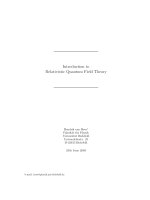
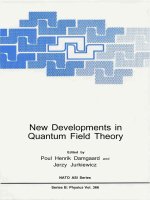

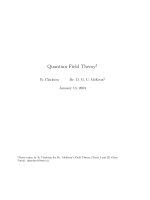
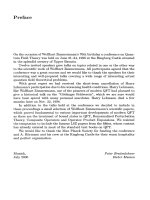

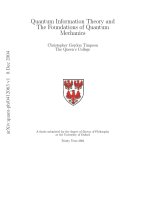
![Some novel thought experiments foundations of quantum mechanics [thesis] o akhavan](https://media.store123doc.com/images/document/14/rc/oh/medium_ohb1395042255.jpg)